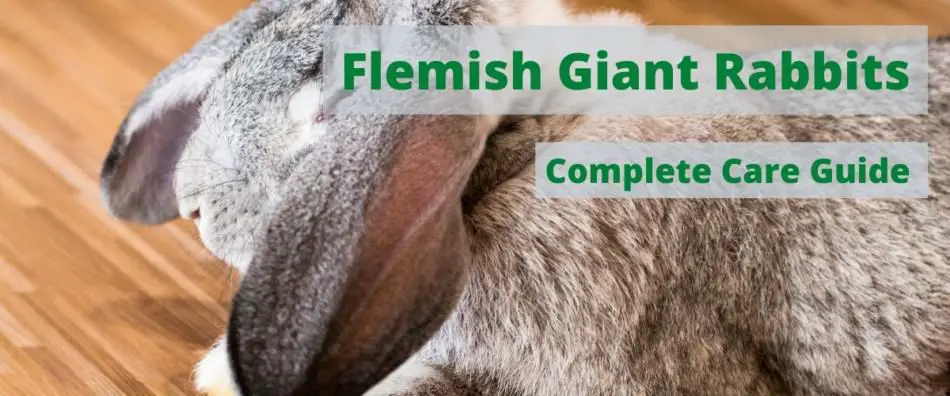The Flemish Giant Rabbit is a truly extraordinary animal. Though they look much like your average Cottontail, they are many times their size!
With a huge, fuzzy animal like this, you can see the appeal… and the Flemish Giant Rabbit has the disposition to match.
These are some of the most easy-going, affectionate, and sociable rabbits out there.
Flemish Giant Rabbits have some special requirements for their care. These are mostly due to their size. They will need more bedding, more food, and so on.
Treat your Flemish Giant Rabbit Right, and they will be the perfect companion for years to come.
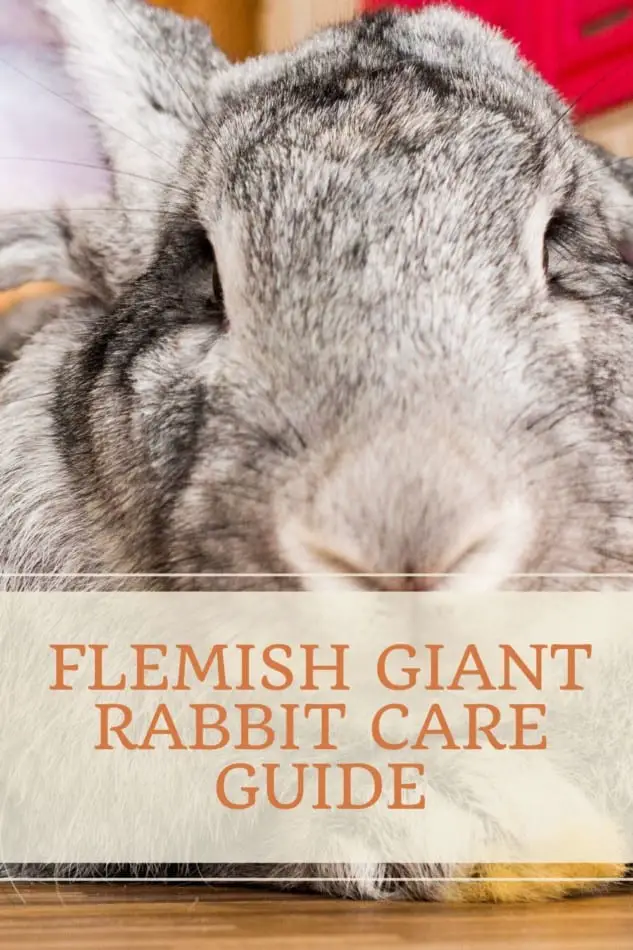
Table of Contents
Origins
The Flemish Rabbit has a prestigious ancestry. They are said to be descended from ancient rabbit breeds, such as the Stone Rabbit and the European Patagonian.
Flemish Giant Rabbits were first recorded in Belgium, in the 16th century. In 1924, they were exported from England to the US. They then became an official charter breed of the American Breeders Association, also known as the ARBA.
Flemish Giant Rabbit Size and Lifespan
The Flemish Giant Rabbit is aptly named the King of Rabbits! These grand bunnies are 2.5-3 feet long, and they weigh 12-20 pounds or more. This is many times the size of your 12-17-inch, 2.5-5 pound Cottontail. They live 5 years on average, sometimes 8 or more.
Flemish Giant Rabbits have a classic, cute, lop-eared appearance, but they are closer in length and weight to a dog than a bunny! Many consider this more to love.
The Flemish Giant Rabbit has thick, luscious fur, which is pleasant to pet and groom. They have enormous lop ears, big, dark eyes, and a sturdy, round body. In short, they are adorable.
You can find Flemish Giant Rabbits in the colors white, sandy, light gray, steel gray, blue, and black.
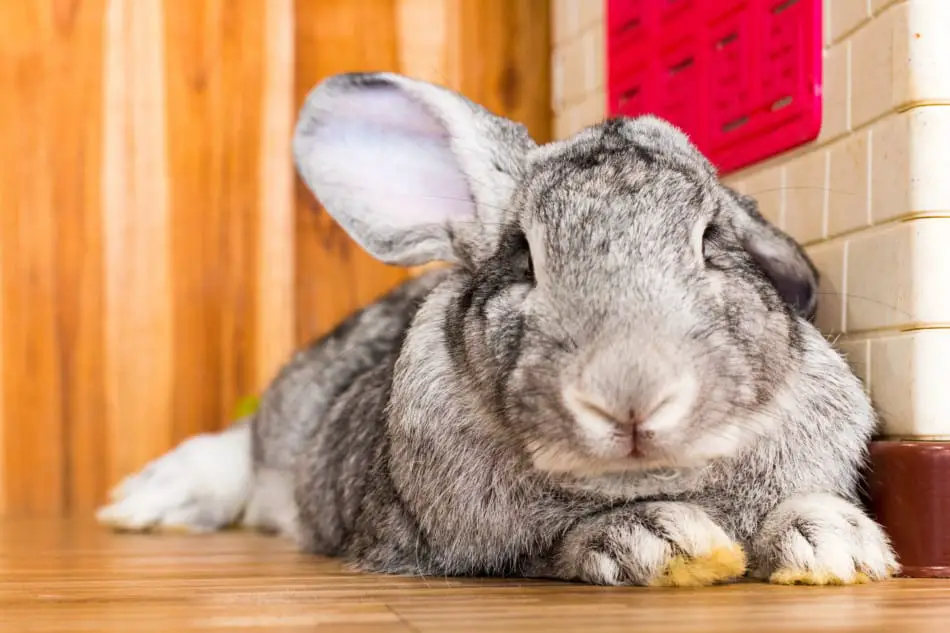
Your Flemish Giant Rabbit Will Need A Big Enclosure
Flemish Giant Rabbits have rather giant space requirements compared to their smaller cousins, like the Cottontail. While cages and hutches may work perfectly well for your average bun, the Flemish Giant Rabbit is 4 times their size or more!
This means that, in order to move about comfortably, they will need much more room. Your rabbit should be able to make at least 3 consecutive jumps, as outlined by Rabbit Welfare.
You can also estimate how much space your rabbit will need specifically! Just multiply their body length by 4.
Since the average Flemish Giant Rabbit is 2.5 feet in length, this is about 10 feet in total.
Clearly, you are unlikely to find a rabbit cage in this size! Housing a Flemish Giant Rabbit can still be simple, but you may need to use a little bit of creativity.
Some of the top outdoor hutch and cage alternatives are converted sheds, aviaries, or dog kennels.
Or you could purchase an Outdoor rabbit run. We love the flexibility of the Omlet range. Which can be expanded with lots of lovely fun tubes, hiding places, and much more. Then are the only pre-made rabbit runs we have found which are big enough for Flemish Giants.
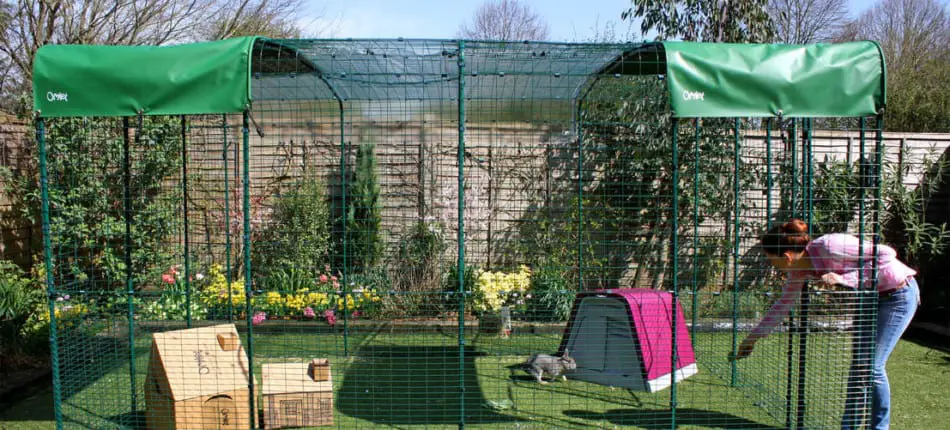
In fact, a suitably sized aviary can be ideal. Just make sure that the bottom of the bird enclosure is solid, rather than mesh. To protect from outside predators, make sure that the bars are made of a strong metal (such as steel).
A shed can also make a great option. All that you need are a few alterations, and you can make it the perfect place for your bun. Include solid mesh windows at the top and bottom of the shed.
This will create adequate ventilation. Secondly, it is strongly recommended to incorporate a run.
These big rabbits will need a generous area to move about, to eat, groom, play, and burrow.
You can also keep your rabbit inside, and these enclosures will still work. Believe it or not, some will also dedicate an entire room to their Flemish Giant Rabbit!
Indeed, out of all of the places your bun could live, an indoor room is ideal. This will keep them well out of reach of predators, allows easy access for socialization, enables you to control the temperature, and so on.
As long as you do it right, your Flemish Giant Rabbit can live indoors or outdoors equally well.
See the full range of Omlet.com rabbit runs and enclosures.
A Flemish Rabbit Cage Must Have A Solid Bottom
The feet and legs of any rabbit breed are extremely sensitive. For them, a mesh bottom can prove extremely uncomfortable.
This goes doubly for the Flemish Giant Rabbit, unfortunately. Their extra weight causes additional strain of their toes and feet, to the extent where they will even develop a condition called ‘sore hock.
A wood floor is a much better alternative. Put some bedding on top, and you can create a really cozy place for your bun to live.
What Every Flemish Giant Rabbit Enclosure Must Have
There must be heaps of bedding in any Flemish Giant Rabbit enclosure! Like any rabbit, they love to burrow. They should have enough bedding to bury themselves in comfortably. Luckily, there are several excellent types of bedding available.
Paper and aspen wood shavings are the top two. This is partly thanks to their ready availability. You can find paper just about anywhere.
Aspen wood shavings can be purchased from your local pet store, or online. You can even home make paper bedding, to save a buck!
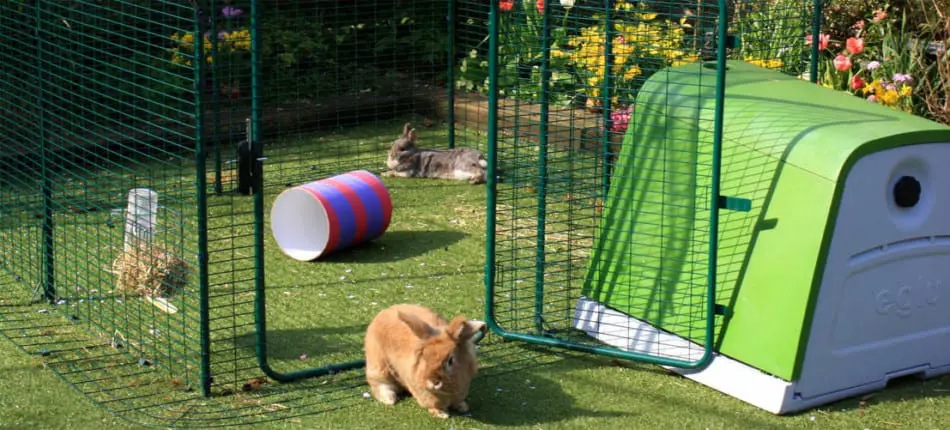
Many opt to use hay as bedding for their Flemish Giant Rabbit, and this can work quite well. However, as you know, rabbits also eat hay. You would not want them to confuse their eating hay with their bedding; or worse, with their litter box!
Make sure that your tidy pet can differentiate between each area clearly. If the bedding is also made of hay, store the eating hay elsewhere in the closure, and high above. Make sure that there are pellets or wood instead of hay in the litter box.
The enclosure should have plenty of accessories to entertain your bun. This includes tunnels, boxes, toys, chew toys, and the like!
Keeping their hay in a special hay rack away from their living area and sleeping compartment is really important. Take a look at our review on some of the best hay rack.
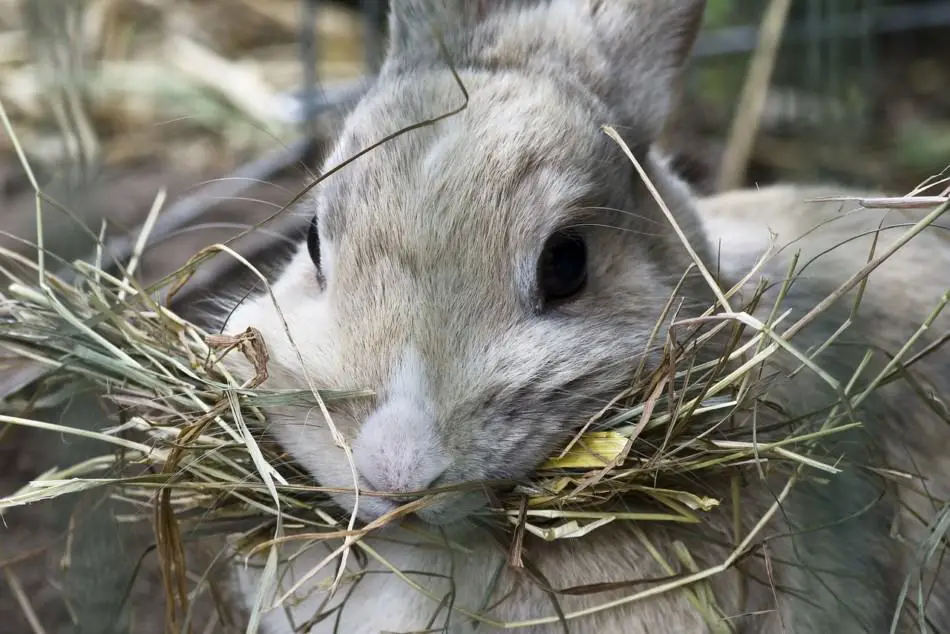
What Should I Feed My Flemish Giant Rabbit?
When it comes to feeding your Flemish Giant Rabbit, there is one keyword: plenty! Compared to the Cottontail, which eats 1-2 handfuls of greens a day, the Flemish Giant Rabbit should have 3-5 handfuls total. They should also eat double the pellets or more.
In fact, Flemish Giant Rabbits eat so much hay that many opt to purchase it in bales, to save money, effort, and time.
So, you now know that your Flemish Giant Rabbit will eat like a very small pony… but, what should you feed them, exactly?
Hay, Hay, and More Hay!
First and foremost, any rabbit, including the Flemish Giant Rabbit, must have constant access to hay. Timothy Hay is probably the best choice available. This variety is particularly low in sugar and high in fiber. For rabbits, this is ideal!
Fiber is perhaps the number one nutrient that these animals require. Unlike us, rabbits have a special organ called a cecum, which allows them to digest fiber and convert it to energy.
Along with this, it keeps their delicate digestive system in balance, preventing blood sugar spikes, and more.
Your rabbit can eat as much hay as they want, without becoming fat or unhealthy. Along with this, the hay will give them something to chew.
This will content them, as well as keep the growth of their teeth in check (rabbit teeth constantly grow).
Fruits Flemish Giant Rabbits Can Safely Enjoy
Your Flemish Giant Rabbits can have some fruits, which they will consider a tasty treat, and eat with pleasure. With fruit, there is one thing you will want to keep in mind: portioning. In the right amount, for rabbits, fruits are fine.
However, fruit is rather high in sugar, and rabbits can have only a small amount of sugar without upsetting their digestive system.
This is because, in the wild, they have a low-sugar diet of grass and hay. Their bodies are not equipped to function differently.
So, while rabbits can have fruit, you will have to limit how much. Your average Cottontail can have one slice of apple, once a day, twice a week.
A Flemish Giant Rabbit can have roughly double that: 1-3 slices of apple, once a day, twice a week.
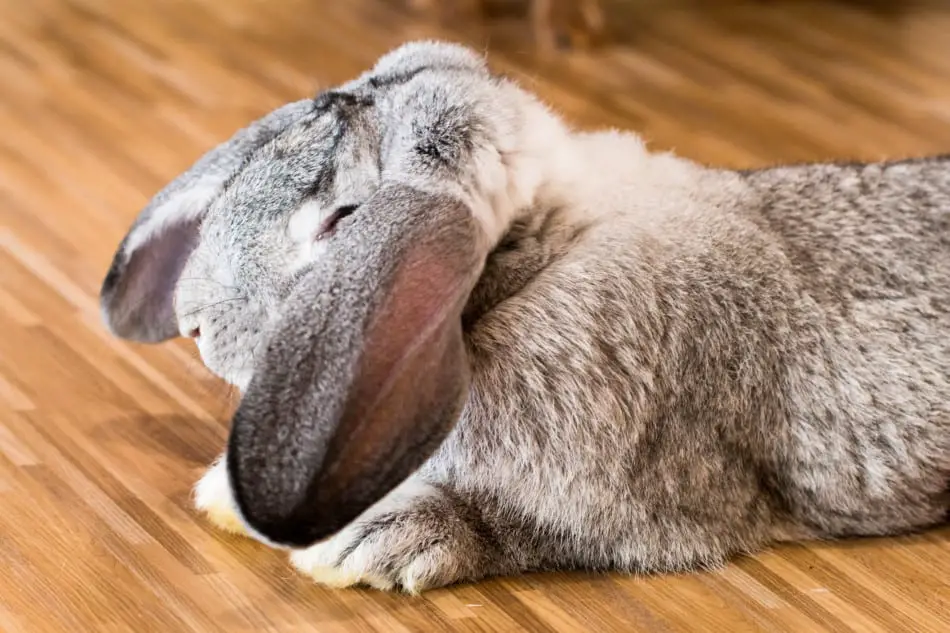
Some fruits are poisonous to Flemish Giant Rabbits (and rabbits of all kinds). Before feeding your rabbit any fruit, double-check that it is safe for them.
Some of the best, safest fruits to feed your Flemish Giant Rabbit are apples (seedless), assorted berries, bananas, mangos, and more.
Many of these are nutrient-rich (especially with vitamin C).
Certain Veggies Make a Nutritious Flemish Giant Rabbit Snack
Veggies are an especially nutritious food that you can offer your bun. These are not only rich in fiber, but low in sugar and high in nutrients as well.
While rabbits can only have fruit a couple of times weekly, they may enjoy veggies a few times a week.
Some great non-toxic vegetables for Flemish Giant Rabbits include bell peppers (a fantastic source of vitamin C), cucumbers (super hydrating), romaine lettuce, pumpkin, squash, sweet potato, and more.
Learn which Fruits and veggies perfect for you Flemish Giant Rabbit here.
Breeding Your Flemish Giant Rabbit Safely
As with any animal, Flemish Giant Rabbits have special requirements in order to be bred safely. To begin with, they must be no less than 8 months old, which is when they mature.
Unlike many animals, rabbits do not have a heat cycle. This means that they can breed at any time. To help breeding go smoothly, there are some useful tips online.
Before you can breed your rabbits, there are a few things that you will absolutely need to know. Most importantly, Flemish Giant Rabbits must only be bred with certain other rabbits (of a particular color or variation).
Otherwise, genetic issues may occur. You can learn more about this online.
You should also have a solid plan for the babies, also known as ‘kits.’ Each will need a proper living environment, attention, veterinary care, and a forever home.
Once you are ready to breed your rabbit, find a large, sturdy, non-slip surface. Set the potential mates here and let nature takes its course.
Do not leave your rabbits unattended during this time, as sometimes, they do not hit it off. They may even fight and do each other harm. Someone must be there to intervene.
You may encourage your Flemish Giant Rabbits to mate about three times, in order to create a good chance at pregnancy. The female rabbit, or ‘doe,’ will give birth in roughly a month (if all goes successfully).
Flemish Giant Rabbits typically have litters of 6-10 babies. Sometimes they will have as many as 20! Or as few as 2.
Your doe (female rabbit) should have somewhere private and comfortable to give birth in their home. While Flemish Giant Rabbits do not require a nesting box, they do need heaps of straw. They will use this to make a nest and burrow.
Cost of Flemish Giant Rabbits and Where To Find Them
Where can you find these lovely animals? Fortunately, Flemish Giant Rabbits are a popular breed, and you can probably find them at your local pet store. They are also available from breeders online.
There are two types of Flemish Giant Rabbits for purchase. These are breeding quality and show quality. Breeding-quality Flemish Giant Rabbits cost about $20-$50.
Pedigreed, show-quality rabbits cost closer to $100-$300, sometimes even more.
The biggest cost is always going to be their home and feeding costs. If you’re going to own a Flemish Giant Rabbit then you have to provide them with the best possible living space and diet.
Keep Your Flemish Giant Rabbit Healthy and Active
Even a Flemish Giant Rabbit rabbit with the roomiest enclosure must be let out once in a while to explore. After all, a life spent only in a cage is not much of a life at all. You can release your rabbit inside, or in a fenced back yard, so long as it is rabbit-proofed properly. Rabbit proofing is quite simple:
- Indoors, put all potted plants, which are usually toxic, up and out of reach. Otherwise, your inquisitive bun may decide to have a sample.
- Indoors, stow cords away. These are something that any rabbit might otherwise decide to chew.
- Indoors, protect your furniture. While all rabbits chew on things, it is no surprise that the Flemish Giant Rabbit is capable of more damage. When left unsupervised, they may decide to gnaw. Never leave your pet unsupervised outside of the enclosure. You will also want to provide some good alternatives for them to chew. Some excellent options are an aspen wood stick or block.
- Outdoors, once again, never leave your pet unsupervised outside of the enclosure. Predators, such as dogs or even birds of prey, can prove a real risk.
- Outdoors, keep your bun out of the garden. There are plenty of poisonous plants there that they may decide to make a snack of.
- Outdoors, never have a Flemish Giant Rabbit out in hot or humid weather. This can cause them to feel unwell, and they can even become sick.
Frequently Clean Your Flemish Giant Rabbit Enclosure
One con of the Flemish Giant Rabbit is that, the bigger the rabbit, the more waste they will create. These are some very big rabbits… which makes for lots of droppings, urine, and so on.
Their bedding needs to be spot-cleaned every day. You must remove droppings, leftover food, bits soaked in urine, and the like.
You should also clean the litter box daily. Along with this, frequently disinfect the entire enclosure (recommended is once weekly). The bedding should be replaced entirely at the end of each week, or sooner if it becomes too dirty or begins to smell.
Teach Your Intelligent Flemish Giant Rabbit To Use The Litter Box
Did you know that rabbits can be litter trained? It’s true, and the process is quite simple! First off, quarantine your new bun in a single room. Until they are litter trained, do not allow them anywhere else in your home.
This is the only way they will learn. You will want to give them the proper environment: bedding, food, etc. Then, you can set up the litter box.
For rabbits, you should never use cat litter, as it is extremely dangerous for them to consume. There are special rabbit litters available (such as aspen wood shavings, paper, etc.).
Unlike cats, rabbits do not bury their droppings. This means that they will need only an inch or two of litter in the box.
From here, you will need to pick up any droppings or urine that your rabbit leaves around the room and deposit them in the litter box.
Most rabbits are smart and adaptable, and will slowly learn to use the litter box.
Just remember, with rabbits, positive reinforcement is key. They are very sensitive and will not respond positively to scoldings or harsh discipline.
Instead, when they use the litter box, pet them and tell them how good they have done.
Once you are sure that your Flemish Giant Rabbit is fully litter trained, you may let them visit the rest of your home.
Flemish Giant Rabbit Grooming and Special Care
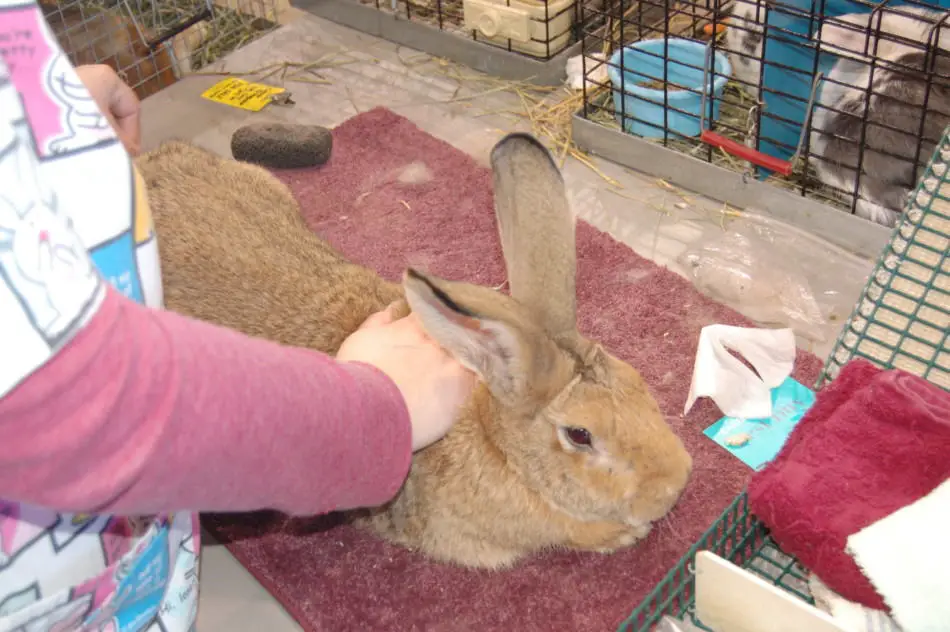
Flemish Giant Rabbits have short, thick fur. They are smooth and soft to the touch, which is quite wonderful. Unfortunately, this ample fur does tend to collect around the enclosure.
Or, worse, your Flemish Giant Rabbit may ingest too much of it and become sick (a condition known as ‘fur block’).
To avoid this, Flemish Giant Rabbits need to be brushed about once a week. Not only will this keep them healthy, but it is a great bonding activity. Grooming is something that the Flemish Giant Rabbit is known to love.
To give your bun a proper brush-down, use a slicker brush. Set aside roughly 20-30 minutes a week. You may need to do this more often when they shed, which is usually in the springtime.
Along with their thick fur, Flemish Giant Rabbits have exceptionally thick nails as well. You will need to keep these trim! Otherwise, as with some dogs, they can grow too long and begin to interfere.
Flemish Giant Rabbits can even experience a condition that can be caused by this, called ‘sore hock.’
Flemish Giant Rabbit Health
Fortunately, Flemish Giant Rabbits are typically healthy creatures. That being said, there are some ailments to which they are prone. Flemish Giant Rabbits get ear mites every once in a while. You should check for these regularly (especially in outdoor rabbits).
Twice a year, you should administer a de-worming paste to your bun, which is mostly preventative.
Flemish Giant Rabbits may also suffer from GI stasis, the common cold, and other, more serious infectious diseases. Take them to the vet right away if they show any signs that they are sick. This includes diarrhea, teary eyes, lethargy, and the like.
Finally, Flemish Giant Rabbits are inclined toward obesity. This is likely because they are not given enough room in their enclosure, or freedom to exercise.
To allow a Flemish Giant Rabbit to become obese is both unhealthy, and inhumane.
Flemish Giant Rabbit Socialization
The Flemish Giant Rabbit is super friendly! Unlike their smaller cousins, they are not especially shy. They are usually even okay with other animals around the home. The Flemish Giant Rabbit is well-mannered and docile.
Something very important to remember about these guys is that they like to be pet and not held. In fact, holding a Flemish Giant Rabbit can do them harm.
This can all too easily bend or strain their back.
Should you attempt to pick up your Flemish Giant Rabbit, they may bite or kick.
When lifting your rabbit is strictly necessary, you may do so with great care.
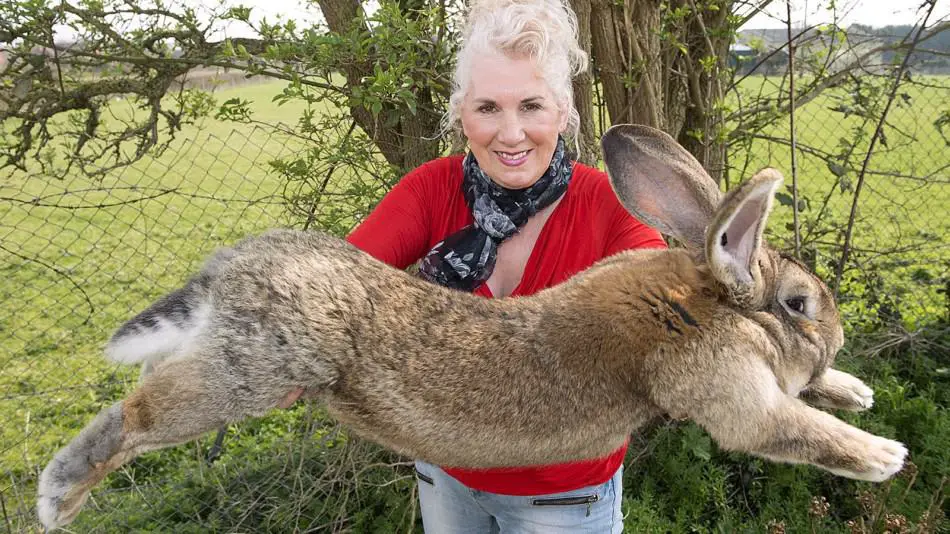
Start by placing your hands under their belly. As you lift, leave one hand under their belly and use the other to support their bottom as well.
Set your rabbit down with equal care.
When a Flemish Giant Rabbit likes you, they may stand up on their hind legs to greet you.
They may bring you toys like a dog, nudge you with their nose for attention, come and sit next to you, and generally behave in a rather darling, affectionate way.
The trick to having a cuddly Flemish Giant Rabbit is to start socializing them early on. Kits should be held (with due care), spoken to, and introduced to folk, as soon as possible.
Conclusion: Flemish Giant Rabbit
Flemish Giant Rabbits do call for a little extra effort, as you can see… but it is well worth your while. In the end, the needs of a Flemish Giant Rabbit are really quite simple.
All that they ask for is a nice, spacious enclosure, some exercise, healthy food, proper hygiene, and a bit of love. In return, they will make a beautiful, well-mannered pet for your home!

